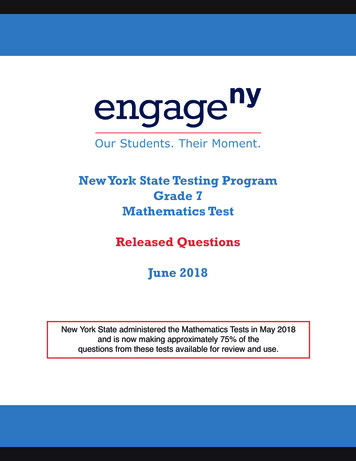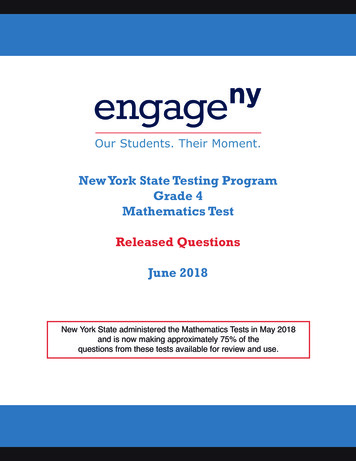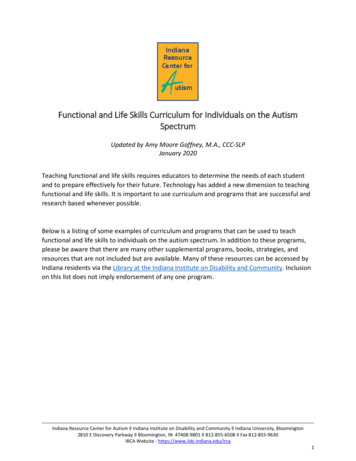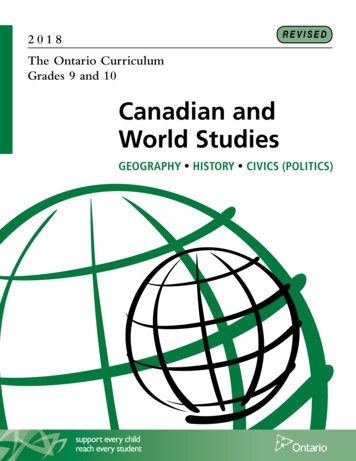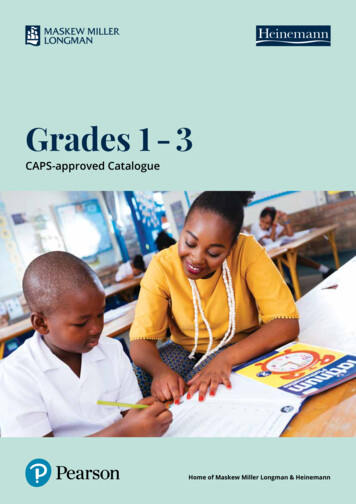
Transcription
Grades 9 to 12MathematicsManitoba CurriculumFramework of Outcomes2014
Gr ades 9 to 12Mathemat icsManitoba CurriculumFramework of Outcomes20142014M a ni t o b a E d u c a t i o n a n d A d v a n c e d L e a r nin g
Manitoba Education and Advanced Learning Cataloguing in Publication DataGrades 9 to 12 mathematics [electronic resource] : Manitoba curriculumframework of outcomes. 2014Based on ‘The common curriculum framework for K-9 mathematics’(2006) and ‘The common curriculum framework for Grades 10-12mathematics’ (2008)/developed by the Western and NorthernCanadian Protocol.Includes bibliographical references.ISBN: 978-0-7711-5804-91. Mathematics—Study and teaching (Secondary).2. Mathematics—Study and teaching (Secondary)—Manitoba.3. Mathematics—Manitoba—Curricula.I. Manitoba. Manitoba Education and Advanced Learning.II. Title: The common curriculum framework for K-9 mathematics.III. Title: The common curriculum framework for Grades 10-12 mathematics.510.71Copyright 2014, the Government of Manitoba, represented by the Minister ofEducation and Advanced Learning.Manitoba Education and Advanced LearningSchool Programs DivisionWinnipeg, Manitoba, CanadaEvery effort has been made to acknowledge original sources and to complywith copyright law. If cases are identified where this has not been done, pleasenotify Manitoba Education and Advanced Learning. Sincere thanks to theauthors, artists, and publishers who allowed their original material to be used.Permission is hereby given to reproduce this document for non-profiteducational purposes provided the source is cited.Any websites referenced in this document are subject to change.Print copies of this resource can be purchased from the Manitoba TextBook Bureau (stock number 80627). Order online at www.mtbb.mb.ca .This resource is also available on the Manitoba Education and AdvancedLearning website at www.edu.gov.mb.ca/k12/cur/math/frameworks.html .Websites are subject to change without notice.Disponible en français.Available in alternate formats upon request.
ContentsGeneral and Specific Learning Outcomesby StrandApplied n3Purpose of the Document3Beliefs about Students and Mathematics Learning3First Nations, Métis, and Inuit Perspectives4Affective Domain4Goals for Students52123Number23Patterns and Relations25Shape and Space32Statistics and Probability35Essential Mathematics38Number38Patterns and Relations40Shape and Space44Statistics and Probability50Pre-Calculus Mathematics53Number53Patterns and Relations557Shape and Space64Mathematical Processes8Statistics and Probability66Nature of Mathematics12Pathways and Topics15Outcomes and Achievement Indicators17Summary18Conceptual Framework for Grades 9 to 12MathematicsInstructional Focus19Contentsiii
General and Specific Learning Outcomes withAchievement Indicators by Course69Grade 9 Mathematics (10F)69Grade 10 Essential Mathematics (20S)85Grade 10 Essential Mathematics—Half Course I87Grade 10 Essential Mathematics—Half Course II93Grade 10 Introduction to Applied andPre-Calculus Mathematics (20S)99Grade 11 Applied Mathematics (30S)111Grade 11 Essential Mathematics (30S)123Grade 11 Essential Mathematics—Half Course III 125Grade 11 Essential Mathematics—Half Course IV 131Grade 11 Pre-Calculus Mathematics (30S)139Grade 12 Applied Mathematics (40S)155Grade 12 Essential Mathematics (40S)169Grade 12 Essential Mathematics—Half Course V171Grade 12 Essential Mathematics—Half Course VI 176Grade 12 Pre-Calculus Mathematics (40S)Referencesiv181199Gr ade s 9 to 12 Mathematic s: Manitoba Cur r ic ulum Fr amewor k of Outc ome s (2014)
AcknowledgementsThe Grades 9 to 12 Mathematics: Manitoba Curriculum Framework of Outcomes is a revision of the Western and Northern Canadian Protocol (WNCP)The Common Curriculum Framework for K–9 Mathematics and The Common Curriculum Framework for Grades 10–12 Mathematics, developed through thecooperative efforts of the four western provinces and three territories. Manitoba Education and Advanced Learning would like to acknowledge thefollowing:Grade 9 MathematicsDevelopment Team(until June 2009)Grades 10 to 12 AppliedMathematics Development Team(until June 2009)Ross AcreeRolling River School DivisionDon BradfordSt. James-Assiniboia School DivisionHarry HodgesPark West School DivisionCarol LarsonSwan Valley School DivisionKelly ScallionMystery Lake School DistrictEthel StevensonPeguis Central SchoolShona TreleavenWinnipeg School Division (retired)Jerrold WiebePembina Trails School DivisionCam BennetMountain View School DivisionTroy BristerBeautiful Plains School DivisionJulie CordovaSt. James-Assiniboia School DivisionSteven EricksonWinnipeg School DivisionRoss ForfarEvergreen School DivisionLeanne Funk BrownLouis Riel School DivisionAcknowledgementsv
Grades 10 to 12 EssentialMathematics Development Team(until June 2009)Grades 10 to 12 Pre-CalculusMathematics Development Team(until June 2009)viApril PoppleSouthwest Horizon School DivisionBrent RichardsBrandon School DivisionKim SklepowichSunrise School DivisionSuzanne DunwoodySeven Oaks School DivisionAlice HarmsMennonite Collegiate InstituteTed JeningaCalvin Christian CollegiateCurt LotherWinnipeg School DivisionCarrie MalanchukSunrise School DivisionKennet MannWinnipeg School DivisionJoe OczerklewiczSt. James-Assiniboia School DivisionEdith SteevesMystery Lake School DistrictDawn BirchSunrise School DivisionSherri BurroughsSt. John’s RavenscourtMelani DecellesWinnipeg School DivisionIan DonnellyRiver East Transcona School DivisionMichael DyckGarden Valley School DivisionBrian HuttonFrontier School DivisionLyn JannuskaBrandon School DivisionRyan MaksymchukSwan Valley School DivisionScott SmithWhiteshell School DivisionGr ade d 9 to 12 Mathematic s: Manitoba Cur r ic ulum Fr amewor k of Outc ome s (2014)
French Committee(until 2009)School Programs Division,Manitoba Education andAdvanced LearningJulie Bacon-PapineauSeine River School DivisionDiane LavergneRiver East Transcona School DivisionNicole Saint-VincentDivision scolaire franco-manitobaineGilles VermetteLouis Riel School DivisionRichard VerrierDivision scolaire franco-manitobaineNicole Allain FoxConsultantCurriculum, Development and ImplementationBureau de l’éducation française DivisionCarole BilykProject LeaderDevelopment UnitInstruction, Curriculum and Assessment BranchLouise BoissonneaultPublications EditorDocument Production Services UnitEducational Resources BranchLee-Ila BotheCoordinator (until March 2010)Document Production Services UnitEducational Resources BranchChris CarmanConsultant (until June 2014)Assessment UnitInstruction, Curriculum and Assessment BranchIan DonnellyConsultant (since February 2012)Development UnitInstruction, Curriculum and Assessment BranchPhilippe LeclercqConsultantCurriculum, Development and ImplementationBureau de l’éducation française DivisionGilbert Le NéalConsultant (until June 2008)Curriculum, Development and ImplementationBureau de l’éducation française DivisionKing LuuConsultant (since June 2013)Assessment UnitInstruction, Curriculum and Assessment BranchGrant MoorePublications EditorDocument Production Services UnitEducational Resources BranchAcknowledgementsvii
viiiCyril ParentDesktop PublisherDocument Production Services UnitEducational Resources BranchAllison PotterConsultant (until June 2013)Assessment UnitInstruction, Curriculum and Assessment BranchBarbara RiouConsultant (until December 2012)Assessment UnitInstruction, Curriculum and Assessment BranchYouyi SunConsultant (since May 2013)Assessment UnitInstruction, Curriculum and Assessment BranchGr ade d 9 to 12 Mathematic s: Manitoba Cur r ic ulum Fr amewor k of Outc ome s (2014)
BackgroundIn December 1993, the Ministers of Education fromAlberta, British Columbia, Manitoba, NorthwestTerritories, Saskatchewan, and Yukon Territory signed theWestern Canadian Protocol (WCP) for Collaboration inBasic Education (Kindergarten toGrade 12). In February 2000,WNCP jurisdictions:following the addition of Nunavut,the protocol was renamed theAlbertaWestern and Northern CanadianBritish ColumbiaProtocol (WNCP) for CollaborationManitobaNorthwest Territoriesin Education (Kindergarten toNunavutGrade 12).SaskatchewanYukon TerritoryIn 2005, the Ministers of Educationfrom all the WNCP jurisdictionsunanimously concurred withthe rationale of the original partnership because of theimportance placed onQQcommon educational goalsQQthe ability to collaborate to achieve common goalsQQhigh standards in educationQQplanning an array of educational opportunitiesQQQQThe original WCP common curriculum frameworkfor mathematics was published in two documents:Kindergarten to Grade 9 in 1995 and Grades 10 to 12 in1996.The Common Curriculum Framework for K–9 Mathematics:Western and Northern Canadian Protocol (May 2006) andThe Common Curriculum Framework for Grades 10–12Mathematics: Western and Northern Canadian Protocol(January 2008) were developed by the seven ministries ofeducation in collaboration with teachers, administrators,parents, business representatives, post-secondaryeducators, and others. The Grades 9 to 12 Mathematics:Manitoba Curriculum Framework of Outcomes is based onboth WNCP common curriculum framework documents.The framework identifies beliefs about mathematicslearning and teaching, general and specific learningoutcomes, and achievement indicators agreed upon by theseven jurisdictions. Each of the provinces and territorieswill determine when and how the framework will beimplemented within its own jurisdiction.removing obstacles to accessibility for individuallearnersoptimum use of limited educational resourcesBackground1
IntroductionPurpose of the DocumentThis document provides sets of learning outcomes to beused as a common base for defining mathematicscurriculum expectations that willbe mandated in Grades 9, 10, 11,The frameworkand 12. This common base shouldcommunicatesresult in consistent studenthigh expectationsoutcomes in mathematics acrossfor students’the WNCP jurisdictions and enablemathematicaleasier transfer for students movinglearnings.from one jurisdiction to another.This document is intended toclearly communicate high expectations for students’mathematical learnings in Grades 9, 10, 11, and 12 to alleducation partners across the jurisdictions, and to facilitatethe development of common learning resources.Beliefs about Students andMathematics LearningStudents are curious, activeMathematicallearners with individual interests,understandingabilities, needs, and career goals.is fostered whenThey come to school with varyingstudents build on theirknowledge, life experiences,own experiences andexpectations, and backgrounds. Aprior knowledge.key component in developingmathematical literacy in students ismaking connections to these backgrounds, experiences,goals, and aspirations.Students construct their understanding of mathematicsby developing meaning based on a variety of learningexperiences.This meaning is best developed when learners encountermathematical experiences that proceed from simple tocomplex and from the concrete to the abstract. The useof manipulatives, visuals, and a variety of pedagogicaland assessment approaches can address the diversity oflearning styles and developmental stages of students.At all levels of understanding, students benefit fromworking with a variety of materials, tools, and contextswhen constructing meaning about new mathematicalideas. Meaningful student discussions also provideessential links among concrete, pictorial, and symbolicrepresentations of mathematics.Students need frequentopportunities to developand reinforce theirconceptualunderstanding,procedural thinking, andproblem-solving abilities.By addressing these threeinterrelated components,students will strengthentheir ability to applymathematical learning totheir daily lives.“Conceptual understandingis defined as comprehendingmathematical concepts,relations, and operations to buildnew knowledge.” (Kilpatrick,Swafford, and Findell 5)Procedural thinking involves“carrying out procedures flexibly,accurately, efficiently, andappropriately.”Problem solving involves“engaging in understanding andresolving problem situationswhere a method or solution isnot immediately obvious.”(OECD 12)Introduction3
The learning environment should value, respect, andaddress all students’ experiences and ways of thinking,so that students are comfortable taking intellectual risks,asking questions and posing conjectures. Students need toexplore mathematics through solving problems in order tocontinue developing personal strategies and mathematicalliteracy. It is important to realize that it is acceptable tosolve problems in different ways and that solutions mayvary depending upon how the problem is understood.best when it is contextualized and not taught as discretecontent.Assessment for learning, assessment as learning, andassessment of learning are all critical to helping studentslearn mathematics. A variety of evidence and a variety ofassessment approaches should be used in the mathematicsclassroom.A variety of teaching and assessment strategies arerequired to build upon the diverse knowledge, cultures,communication styles, skills, attitudes, experiences, andlearning styles of students.First Nations, Métis, and Inuit PerspectivesFirst Nations, Métis, and Inuit students in Manitoba comefrom diverse geographic areas and have varied culturaland linguistic backgrounds. Students attend schools in avariety of settings, includingurban, rural, and isolatedTeachers needcommunities. Teachers need toto understand therecognize and understand thediversitydiversity of cultures within schoolsof students’ culturesand the diverse experiences ofand experiences.students.First Nations, Métis, andInuit students often have a whole-world view of theenvironment; as a result, many of these students live andlearn best in a holistic way. This means that studentslook for connections in learning and learn mathematics4Many First Nations, Métis, and Inuit students come fromcultural environments where learning takes place throughactive participation. Traditionally, little emphasis wasplaced upon the written word. Oral communication, alongwith practical applications and experiences, is important tostudent learning and understanding.The strategies used must go beyond the incidentalinclusion of topics and objects unique to a culture orregion and strive to achieve higher levels of multiculturaleducation (Banks and Banks, 1993).Affective DomainA positive attitude is an important aspect of the affectivedomain that has a profound effect on learning.Environments that create a sense of belonging, supportrisk taking, and provideopportunities for success helpTo experiencestudents to develop and maintainsuccess, studentspositive attitudes and selfmust be taught to setconfidence. Students with positiveachievable goals andattitudes toward learningassess themselvesmathematics are likely to beas they work towardmotivated and prepared to learn,these goals.to participate willingly inK inder gar ten to Gr ade 8 Mathematic s Manitoba Cur r ic ulum Fr amewor k of Outc ome s: (2013)
classroom activities, to persist in challenging situations,and to engage in reflective practices.Teachers, students, and parents need to recognize therelationship between the affective and cognitive domainsand to nurture those aspects of theaffective domain that contribute toCuriosity aboutpositive attitudes. To experiencemathematics issuccess, students must be taught tofostered when studentsset achievable goals and assessare actively engaged intheir environment.themselves as they work towardthese goals.Striving toward success and becoming autonomous andresponsible learners are ongoing, reflective processes thatinvolve revisiting the setting and assessing of personalgoals.QQcommit themselves to lifelong learningbecome mathematically literate citizens, usingmathematics to contribute to society and to thinkcritically about the worldStudents who have met these goalsQQgain an understanding and appreciation of the role ofmathematics in societyQQexhibit a positive attitude toward mathematicsQQengage and persevere in mathematical problem solvingQQcontribute to mathematical discussionsQQtake risks in performing mathematical tasksQQexhibit curiosity about mathematics and situationsinvolving mathematicsIn order to assist students in attaining these goals, teachersare encouraged to develop a classroom atmosphere thatfosters conceptual understanding throughGoals for StudentsThe main goals of mathematics education are to preparestudents toQQMathematics educationmust prepare studentsto use mathematics tothink critically aboutthe world.QQQQQQcommunicate and reasonmathematicallyuse mathematics confidently,accurately, and efficiently to solveproblemsappreciate and value mathematicsmake connections betweenmathematical knowledge and skills and theirapplicationsQQtaking risksQQthinking and reflecting independentlyQQsharing and communicating mathematicalunderstandingQQsolving problems in individual and group projectsQQpursuing greater understanding of mathematicsQQappreciating the value of mathematics throughouthistoryQQIntroduction5
Conceptual FrameworkforGrades 9to12 Mathemat icsThe chart below provides an overview of how mathematical processesand the nature of mathematics influence learning TANCYNUMBER SENSEPATTERNSRELATIONSHIPSSPATIAL SENSEUNCERTAINTY101112The topics of study vary in the courses forGrades 9 to 12 mathematics.Topics include:AlgebraFinancial MathematicsGeometryLogical ReasoningMeasurementNumberProbabilityRelations and FunctionsStatisticsTrigonometryMATHEMATICAL PROCESSES:GENERAL LEARNING OUTCOMES,SPECIFIC LEARNING OUTCOMES,AND ACHIEVEMENT INDICATORSCOMMUNICATION, CONNECTIONS, MENTALMATHEMATICS AND ESTIMATION, PROBLEM SOLVING,REASONING, TECHNOLOGY, VISUALIZATIONConceptual Framework for Grades 9 to 12 Mathematics7
Mathematical ProcessesThe seven mathematical processes are critical aspects oflearning, doing, and understanding mathematics. Studentsmust encounter these processes regularly in a mathematicsprogram in order to achieve the goals of mathematicseducation.The common curriculum framework incorporates thefollowing interrelated mathematical processes. It isintended that they permeate the teaching and learning ofmathematics.Students are expected toQQnnnnnnnCommunication [C]Connections [CN]Mental Mathematicsand Estimation [ME]Problem Solving [PS]Reasoning [R]Technology [T]Visualization [V]QQQQQQQQQQQQ8use communication in orderto learn and express theirunderstandingmake connections amongmathematical ideas, otherconcepts in mathematics,everyday experiences, and otherdisciplinesdemonstrate fluency with mentalmathematics and estimationdevelop and apply new mathematical knowledgethrough problem solvingdevelop mathematical reasoningselect and use technology as a tool for learning andsolving problemsdevelop visualization skills to assist in processinginformation, making connections, and solving problemsAll seven processes should be used in the teaching andlearning of mathematics. Each specific learning outcomeincludes a list of relevant mathematical processes. Allseven processes should be incorporated into learningexperiences but the identified processes are to be used as aprimary focus of instruction and assessment.Communication [C]Students need opportunities toread about, represent, view, writeabout, listen to, and discussmathematical ideas. Theseopportunities allow students tocreate links among their ownlanguage and ideas, the languageand ideas of others, and theformal language and symbols ofmathematics.Students mustbe able tocommunicatemathematical ideas ina variety of ways andcontexts.Communication is important in clarifying, reinforcing,and modifying ideas, attitudes, and beliefs aboutmathematics. Students should be encouraged to usea variety of forms of communication while learningmathematics. Students also need to communicate theirlearning using mathematical terminology.Communication can play a significant role in helpingstudents make connections among concrete, pictorial,graphical, symbolic, verbal, written, and mentalrepresentations of mathematical ideas. Explanationof ideas should use the various representations asappropriate.Gr ade s 9 to 12 Mathematic s: Manitoba Cur r ic ulum Fr amewor k of Outc ome s (2014)
Emerging technologies enable students to engage incommunication beyond the traditional classroom to gatherdata and share mathematical ideas.Connections [CN]Contextualization and making connections to theexperiences of learners are powerful processes indeveloping mathematical understanding. Whenmathematical ideas are connected to each other or to realworld phenomena, students begin to view mathematics asuseful, relevant, and integrated.Through connections,students begin to viewmathematics as usefuland relevant.Learning mathematics withincontexts and making connectionsrelevant to learners can validatepast experiences and increasestudent willingness to participateand be actively engaged.The brain is constantly looking for and makingconnections. “Because the learner is constantly searchingfor connections on many levels, educators need toorchestrate the experiences from which learners extractunderstanding Brain research establishes and confirmsthat multiple complex and concrete experiences areessential for meaningful learning and teaching” (Caineand Caine 5).Mental Mathematics and Estimation [ME]Mental mathematics and estimation is a combination ofcognitive strategies that enhance flexible thinking andnumber sense. It involves using strategies to performmental calculations.Mental mathematics enables students to determineanswers without paper and pencil. It improvescomputational fluency by developing efficiency, accuracy,and flexibility in reasoning and calculating.“Even more important thanperforming computationalprocedures or using calculators isthe greater facility that studentsneed—more than ever before—with estimation and mentalmath” (National Council ofTeachers of Mathematics,May 2005).Mental mathematicsand estimationare fundamentalcomponents of numbersense.Students proficient with mental mathematics “becomeliberated from calculator dependence, build confidence indoing mathematics, become more flexible thinkers and aremore able to use multiple approaches to problem solving”(Rubenstein 442).Mental mathematics “provides a cornerstone for allestimation processes, offering a variety of alternativealgorithms and nonstandard techniques for findinganswers” (Hope v).Estimation is used for determining approximate values orquantities, usually by referring to benchmarks or referents,or for determining the reasonableness of calculated values.Estimation is also used to make mathematical judgmentsand to develop useful, efficient strategies for dealing withsituations in daily life. When estimating, students need tolearn which strategy to use and how to use it.Conceptual Framework for Grades 9 to 12 Mathematics9
To help students become efficient with computationalfluency, students need to develop mental math skills andrecall math facts automatically. Learning math facts is adevelopmental process where the focus of instruction is onthinking and building number relationships. Facts becomeautomatic for students through repeated exposure andpractice. When a student recalls facts, the answer shouldbe produced without resorting to inefficient means, suchas counting. When facts are automatic, students are nolonger using strategies to retrieve them from memory.Problem Solving [PS]”Problem solving is an integral part of all mathematicslearning” (NCTM, Problem Solving). Learning throughproblem solving should be the focus of mathematics at allgrade levels. Students develop a true understanding ofmathematical concepts and procedures when they solveproblems in meaningful contexts. Problem solving is to beemployed throughout all of mathematics and should beembedded throughout all the topics.When students encounter new situations and respond toquestions of the type, How would you.? or How could you.?,the problem-solving approach is being modelled. Studentsdevelop their own problem-solving strategies by listeningto, discussing, and trying different strategies.Learning throughproblem solvingshould be the focusof mathematics at allgrade levels.10In order for an activity to be basedon problem solving, it must askstudents to determine a way to getfrom what is known to what issought. If students have alreadybeen given ways to solve theproblem, it is not a problem, butpractice. Students should not know the answerimmediately. A true problem requires students to use priorknowledge in new ways and contexts. Problem solvingrequires and builds depth of conceptual understandingand student engagement. Students will be engaged if theproblems relate to their lives, cultures, interests, families,or current events.Both conceptual understanding and student engagementare fundamental in moulding students’ willingness topersevere in future problem-solving tasks.Problems are not just simple computations embedded in astory, nor are they contrived. They are tasks that are richand open-ended, so there may be more than one way ofarriving at a solution or there may be multiple answers.Good problems should allow for every student in the classto demonstrate their knowledge, skill, or understanding.Problem solving can vary from being an individualactivity to a class (or beyond) undertaking.In a mathematics class, there are two distinct types ofproblem solving: solving contextual problems outside ofmathematics and solving mathematical problems. Findingthe maximum profit given manufacturing constraints isan example of a contextual problem, while seeking anddeveloping a general formula to solve a quadratic equationis an example of a mathematical problem.Problem solving can also be considered in terms ofengaging students in both inductive and deductivereasoning strategies. As students make sense of theproblem, they will be creating conjectures and lookingfor patterns that they may be able to generalize. This partof the problem-solving process often involves inductivereasoning. As students use approaches to solving theGr ade s 9 to 12 Mathematic s: Manitoba Cur r ic ulum Fr amewor k of Outc ome s (2014)
problem they often move into mathematical reasoningthat is deductive in nature. It is crucial that students beencouraged to engage in both types of reasoning and begiven the opportunity to consider the approaches andstrategies used by others in solving similar problems.Problem solving is a powerful teaching tool that fostersmultiple creative and innovative solutions. Creating anenvironment where students openly look for, and engagein, finding a variety of strategies for solving problemsempowers students to explore alternatives and developsconfident, cognitive mathematical risk-takers.Reasoning [R]Mathematical reasoning helps students think logically andmake sense of mathematics. Students need to developconfidence in their abilities toreason and justify theirMathematicalmathematical thinking. Questionsreasoning helpsthat challenge students to think,students think logicallyanalyze, and synthesize help themand make sense ofdevelop an understanding ofmathematics.mathematics. All students need tobe challenged to answer questionssuch as “Why do you believe that’s true/correct?” or “Whatwould happen if ?”.Mathematical experiences provide opportunities forstudents to engage in inductive and deductive reasoning.Students use inductive reasoning when they explore andrecord results, analyze observations, make generalizationsfrom patterns, and test these generalizations. Students usedeductive reasoning when they reach new conclusionsbased upon the application of what is already known orassumed to be true. The thinking skills developed byfocusing on reasoning can be used in daily life in a widevariety of contexts and disciplines.When explaining ideas, students should be encouragedto use concrete, pictorial, symbolic, graphical, verbal, andwritten representations of their mathematical ideas.Technology [T]Technology can be used effectively to contribute to andsupport the learning of a wide range of mathematicallearning outcomes. Technology enables students toexplore and create patterns, examine relationships, testconjectures, and solve problems. Students in Grades 9 to12 are expected to have consistent access to technology fortheir mathematics courses.Technology has the potential to enhance the teaching andlearning of mathematics. It can be used toQQQQQQQQQQexplore and demonstratemathematical relationshipsand patternsorganize and display datagenerate and test inductiveconjecturesextrapolate and interpolateassist with calculationprocedures as part of solvingproblemsTechnologycontributes to thelearning of a widerange of mathematicaloutcomes, and enablesstudents to exploreand create patterns,examine relationships,test conjectures, andsolve problems.Conceptual Framework for Grades 9 to 12 Mathematics11
QQQQQQincrease the focus on conceptual understanding bydecreasing the time spent on repetitive proceduresreinforce the learning of basic factsdevelop personal procedures for mathematicaloperationsQQmodel situationsQQdevelop number and spatial senseQQcreate geometric figuresTechnology contributes to a learning environmentin which the curiosity of students can lead to richmathematical discoveries at all grade levels.Students need to know when it is appropriate to usetechnology such as a calculator and when to apply theirmental computation, reasoning, and estimation skillsto predict and check answers. The use of technologycan enhance, although it should not replace, conceptualunderstanding, procedural thinking, and problem solving.Being able to create, interpret, and describe a visualrepresentation is part of spatial sense and s
Acknowledgementsv ac k n o w l e d G e M e n t s The Grades 9 to 12 Mathematics: Manitoba Curriculum Framework of Outcomes is a revision of the Western and Northern Canadian Protocol (WNCP) The Common Curriculum Framework for K–9 Mathematics and The Common Curriculum Framework for Grades 10–12 Mathem
